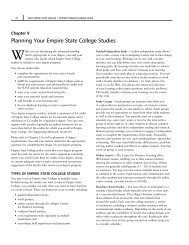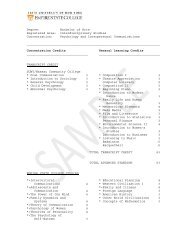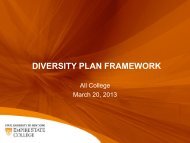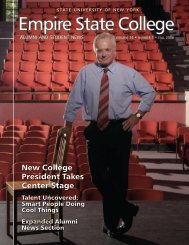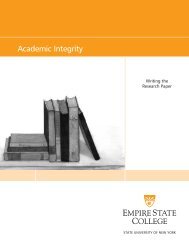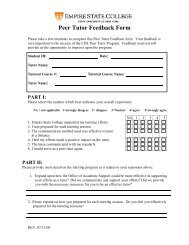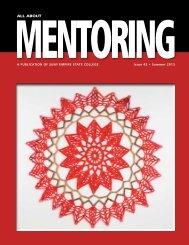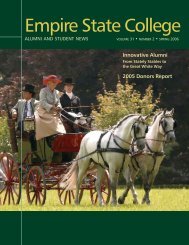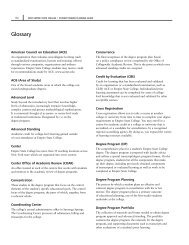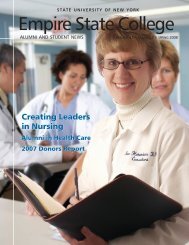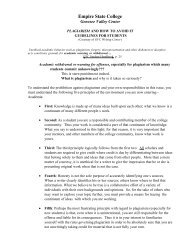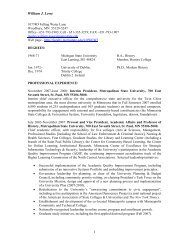Academic Plan 2011-2015 (PDF 524kB) - SUNY Empire State College
Academic Plan 2011-2015 (PDF 524kB) - SUNY Empire State College
Academic Plan 2011-2015 (PDF 524kB) - SUNY Empire State College
You also want an ePaper? Increase the reach of your titles
YUMPU automatically turns print PDFs into web optimized ePapers that Google loves.
12 <strong>SUNY</strong> <strong>Empire</strong> <strong>State</strong> <strong>College</strong>: <strong>Academic</strong> <strong>Plan</strong> <strong>2011</strong> - <strong>2015</strong>Acceleration and combined undergraduate/graduate educationThe academic plan supports efforts within the college to accelerate degree completion, for thosestudents who are identified to have the potential to successfully move from undergraduate to graduatelevel study. Efforts should focus on formally creating opportunities for identified undergraduatestudents to take dual-enrollment studies with approval and review by graduate program faculty.Collaboration with other colleges and sectorsIn light of diminishing state support, institutions of higher education must begin to work acrossboundaries. Where possible, <strong>SUNY</strong> <strong>Empire</strong> <strong>State</strong> <strong>College</strong> should play a lead role in collaboration. Thecollege has a strong history in collaborating with community colleges, and could build on that historywith stronger faculty-to-faculty collaboration and more disciplinary-specific pathways programs. We areexperts in adult degree completion, and developments with the Open University could promote greaterformal coordination between <strong>SUNY</strong> and CUNY institutions, with corporate and community partners, aswell as international partnerships and foreign language development.Prior learning assessment<strong>Empire</strong> <strong>State</strong> <strong>College</strong>, from its long tradition of recognizing that learning can occur from nontraditionalsources, is viewed as a leader in the field of prior learning assessment (PLA). While the individualassessment of student learning should remain central and supported by sufficient resources, developingadditional generic evaluations in targeted areas such as health care, business, the arts, and humanservices, would increase visibility and partnerships with professional groups and organizations, andopen more opportunities for earlier degree completion. The time and resources required to developand maintain current generics could offset the time and resources required to replicate the individualevaluation process across individual centers and students. (See also Theme B, Goal Three)Objective A1.2: Identify criteria for new academic program developmentFinally, in order to create a framework for academic program development and support, the academicplan seeks to establish criteria for new academic programs. These criteria are intended to assuretransparency and equity in the development of new programs, and are intended to be applied acrossthe college to any new program at any academic level, whether it is at the undergraduate, registered,area-of-study level, the certificate level, or a proposed new graduate program or certificate.Six criteria are proposed to constitute a framework for support of academic program development. Aproposal for academic program development will receive favorable attention to the extent that it:1. advances or is consistent with the college’s mission and core values2. supports the college’s strategic plan and other major college and <strong>SUNY</strong> initiatives and mandates3. represents a growth area or economic opportunity4. integrates effectively with other curricular areas and is conducive to interdisciplinary approachesto program and curriculum development5. reflects and builds on the expertise of our faculty6. serves students’ needs for increasingly diverse programmatic options




